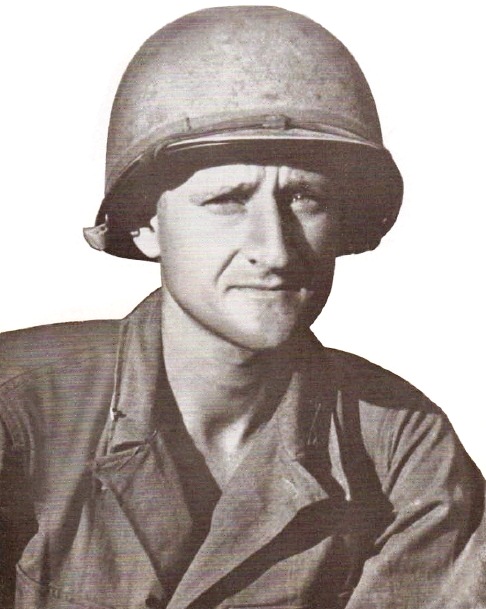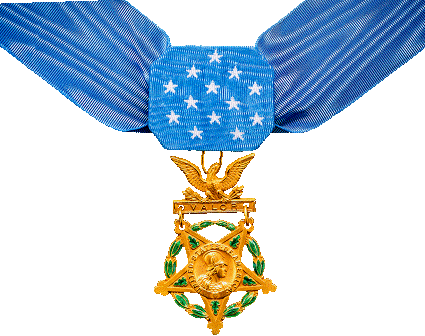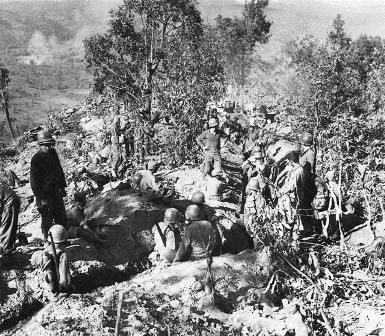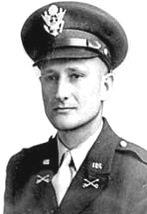
|
|
|
|
The only Medal of Honor earned by a member of U.S. Army ground forces in the China-Burma-India Theater was posthumously awarded to 1st Lt. Jack L. Knight of the 124th Cavalry, Mars Task Force, for gallantry in action in Burma. The Mars troop commander was killed in action in an assault on a strategic hill near Loi-kang, on the Burma Road, February 2, 1945. Knight's actions took place during the bloodiest fighting of the Burma campaign for the Mars Task Force. The objective was to cut the Burma Road 30 miles below its junction with the Ledo Road. The Mars Task Force, officially the 5332d Brigade (Provisional), was a long-range penetration unit similar to Merrill's Marauders. It consisted of three regiments. One contained the survivors of Merrill's Marauders, which had been reorganized, brought up to strength with replacements from the United States, and redesignated the 475th Infantry Regiment. Another was the 124th Cavalry Regiment, a dismounted former National Guard unit from Texas functioning as infantry. The third, considered to be an elite unit, was the U.S. trained and equipped 1st Chinese Regiment (Separate). The Mars Task Force was given the mission of clearing Northern Burma of Japanese forces and opening the Burma Road for truck traffic to China. In order to accomplish this mission, the force moved more than 200 miles by foot over the most hazardous terrain in Burma, over mountainous jungles, steep trails, swift streams and rivers on hot days and cold nights, in rain and mud. This was all done while being cut off completely from friendly forces and having to depend entirely upon air supply. The 124th established contact with the enemy on January 19, 1945, and fought continuously for 17 days. The objective was secured around February 15, 1945.
On the morning of February 2, 1945, Knight and his men started out at 6:20 a.m. Following a barrage, Knight's troop "F" moved 1,500 yards through the Hosi Valley jungle, then up a 250-foot slope towards the objective. Only two Japanese were met on the way. Knight killed them both with his carbine. Knight and his men reached their objective after 35 minutes. The men began to dig in. Knight reconnoitered the slope at the end of the hill. He spotted an enemy pillbox and grenaded it. He found two more pillboxes and gave them the same treatment. Knight called to his men, "Come on up. There's a whole nest of them here." His men obeyed. Knight found himself in the center of a horseshoe formation of pillboxes. He threw a grenade into his fourth pillbox, then fired his carbine into it. Men who later described the scene said Knight acted as if he were out to get every pillbox himself. A Japanese soldier tossed a grenade at the lieutenant. He backed away but the burst caught him full in the face. As he turned around and walked back to Lt. Leo C. Tynan to get more carbine ammunition, the men saw blood dripping from his face. Another enemy soldier tried to bayonet Knight as he walked past a pillbox. Lt. Tynan killed him. Knight took half of Tynan's ammunition and started forward again. As he broke into a run, he muttered to Tynan, "I can't see." The troop had caught up with him by then. Concentrated fire came from the pillboxes. Men were falling all around Knight. He regrouped his squads by arm motions and went out in front again. He grenaded his fifth Pillbox. An enemy grenade landed nearby and wounded him a second time. This time he went down. But as he lay there, he kept shouting encouragement to his men. Lt. Knight's brother, 1st Sgt. Curtis Knight, saw his brother fall and ran forward to lead the troop. But he was dropped by a bullet under the heart. The lieutenant asked one of the men to get his brother back to an aid station. He continued to encourage his men. Then, on his hands and knees, he started to crawl towards another enemy pillbox. He was hit by a bullet. It was the end for Lt. Jack Knight. His men went on to take the objective. His brother, flown to an evacuation hospital, recovered. Three days later Lt. Jack Knight was buried on the hill he had given his life to capture. In recognition of his valor, Southeast Asia Commander Admiral Lord Louis Mountbatten ordered the objective be named "Knight's Hill" and be shown that way on official Theater maps. The action became known as "The Battle of Knight's Hill." His regimental commander, Colonel William F. Osborne, veteran of Bataan and Merrill's Marauders, said of Jack Knight: "In more than four years of combat, I have seen many officers fight and die, but Lt. Knight's action in leading his troop to its objective against strong enemy concentrations is to me the finest example of courage, valor and leadership of any officer I have ever commanded. "What Lt. Knight did that day is something for every American to be proud of. It is officers of Jack Knight's caliber and the troops that follow his kind of leadership that are winning the war - not colonels and generals." Major Thomas J. Newton, Knight's previous commanding officer with the 124th Cavalry shared: "There were three Knight boys in my troop. Jack, Curtis and Lloyd in that order. Jack and Lloyd went to OCS but I couldn't persuade Curtis to go. He had just been married and didn't want to leave his wife. "Jack went to Cavalry OCS at Ft. Riley. Lloyd came out as a Tank Destroyer officer and I lost track of him. When Jack received his commission, we naturally wanted him back with us. So he returned and headed a reconnaissance platoon. Later he became commander of F Troop over here, with Curtis as his first sergeant." "You know," the major said, "I never was certain which was the best soldier of those three brothers. Jack's deeds in Burma didn't surprise me, nor did Curtis's. I knew they had it in them. I think the story and the death of Jack Knight actually is the story of the Knight family." Jack Knight's Medal of Honor citation of June 6, 1945 reads as follows:
On June 25, 1945, the Medal of Honor was presented to his father, Roy Knight, by General Bruce Magruder at Camp Wolters, Texas. Jack Knight's body was returned from Burma and buried in Holders Memorial Chapel Cemetery at Cool, Texas
Jack Llewellyn Knight was born in Garner, Texas, on May 29, 1917. He attended elementary school at Valley Springs and Garner High School, and graduated from Weatherford Junior College, in Weatherford, Texas, in 1938. In October of 1940, Jack and his two brothers, Curtis and Lloyd, enlisted in the 124th Cavalry at Mineral Wells, Texas. The 124th Cavalry Regiment, part of the 56th Cavalry Brigade, Texas National Guard, was mobilized for active duty on November 18, 1940. The Regiment was initially stationed at Fort Bliss, El Paso, but was reassigned to Fort Brown in Brownsville, and Fort Ringgold in Rio Grande City, replacing the 12th United States Cavalry. The Regiment participated in the Louisiana maneuvers and patrolled the border with Mexico from Brownsville to Laredo. After its sister regiment, the 112th Cavalry Regiment was sent overseas, the 124th Cavalry remained a part of the 56th Cavalry Brigade until May 12, 1944, when it was moved to Fort Riley, Kansas. At that time, the Regiment was the last horse-mounted regiment in the United States Army. The Regiment turned in its horses on June 10, 1944, and departed Fort Riley on July 25. It landed in Bombay, India, on August 26, 1944. Reinforced with the 613th Field Artillery Battalion, and redesignated "Special," it became part of the Mars Task Force and moved into the mountains of Northern Burma on December 15, 1944. On January 19, 1945 the 124th Cavalry of the Mars Task Force began an engagement with the enemy that led to the Battle of Knight's Hill. See a story of the battle -
HERE

CLICK HERE TO ENLARGE 
|
This page was compiled using information from various internet sites as indicated by Wikipedia
Copyright © 2014 Carl W. Weidenburner


